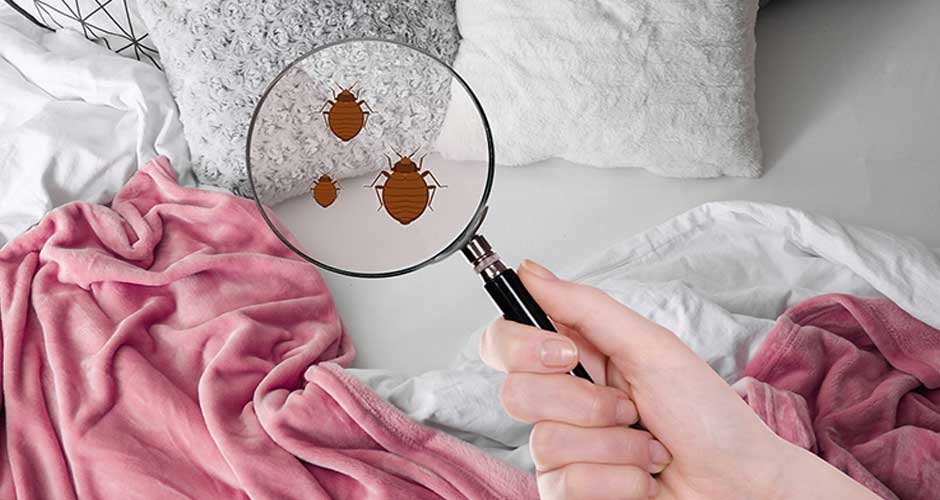Despite their small size, bed bugs can still cause significant discomfort and stress if they invade your home. The first step is to quickly identify bed bugs in order to prevent a serious infestation. This detailed guide will help you learn how to check your home for bed bugs and what to do if you find an infestation.
Visual Inspection of Common Hiding Spots
Begin by examining areas where bed bugs typically seek shelter.
Inspect your:
- mattress;
- box spring;
- bed frame;
- headboard;
- and footboard for seams, folds, and tufts.
Use a flashlight and magnifying glass to examine nearby furniture:
- nightstands;
- upholstery chairs;
- sofas;
- and under cushions.
Bed bugs can infest any area frequented by humans, not just limited to beds. Therefore, review places where you often stay, like couches, seats, and even power sockets. Be sure to check places like curtains, wall decorations, and picture frames that aren’t so obvious. The best time to find bed bugs more effectively is to check for them in the evening or early in the morning. And here comes the hidden clue: bed bugs are active at night, that’s why if you search for them during the day, you may not find them.
Utilise Bed Bug Interception Devices
You should use bed bug interception devices to identify bed bugs moving in or out of your furniture. These items are positioned beneath the bed frame and furniture legs, forming an obstacle bed bugs must overcome to reach their host. Interception devices catch bed bugs when they try to move between their hiding places and the host, showing there is an infestation. Consistently check and supervise interception tools for indications of bed bug presence, like living bugs or faecal marks, to assess the severity of the infestation and monitor the success of treatment methods.
You can make your own bed bug traps using everyday household objects like double-sided tape or shallow containers filled with soapy water. Position these traps strategically throughout your residence, concentrating on locations where bed bugs are expected to pass through. Regularly inspect the traps for indications of bed bugs and change them when necessary to ensure efficacy. These traps function as a preemptive detection method for identifying bed bugs and enable you to take proactive actions to handle infestations before they worsen.
Conduct a Thorough Clothing and Belongings Inspection
Bed bugs are skilled at taking advantage of situations and can quickly cling onto garments, bags, and personal possessions, underscoring the importance of carefully examining these items. Take out all clothes and any other fabrics that you have from drawers, closets, and storage bins and inspect them for indications of bed bugs or their eggs. Be sure to carefully inspect seams, folds, and pockets where bed bugs could be hiding, and shake out clothes before putting them away. In case you have recently been on a trip or stayed in a place with signs of bed bugs, make sure to launder all clothes and items in high heat to get rid of any bed bugs hiding in them.
With a vacuum and steam cleaner, you can get rid of bed bugs and their eggs all over furniture, curtains, and carpets. Steam cleaning can kill bed bugs at any stage of their existence, reaching deep into fabrics and crevices. While cleaning, use a vacuum cleaner with a HEPA filter to trap all the possible allergens. Be sure to use a heavy steam pressure to penetrate all cracks and crevices. Allow the area to dry completely before re-occupying.
Seek Professional Pest Control Assistance
Pest control companies have the advantage of using chemicals and other treatments that are not available to you and to a wide audience. Insecticides that they use have the ability to kill bugs on contact as well as stay inside furniture and cracks over the long term so that bedbugs cannot reproduce.
As another type of treatment, pest control companies will use whole-room heat treatments, in which special equipment raises the room’s temperature to 135-145°F (57.22-62.78°C) in order to eliminate bedbugs.
Before the pest control service is performed, the chosen company must give you instructions on how to prepare your home for the upcoming treatment. By carefully following their instructions, you increase your likelihood of successfully eradicating the bugs.
Professional treatments take two to three visits to start working. It is possible that you will be required to stay out of the treated rooms for a few hours after each treatment to allow the insecticides to dry. A couple of days at your friends’ or family’s would be a good idea to be sure.
Implement Preventive Measures to Avoid Future Infestations
As said above, if you ask the pest control technicians for advice on preventative measures, use them. Good hygiene practices, such as regularly washing bedding, vacuuming floors, and decluttering your living space, are the first things to avoid any infestation. Encase mattresses and box springs with bed bug-proof cover to prevent reinfestation and make it easier to detect any residual bed bugs.
Think twice before acquiring second-hand furniture or clothing, as these are common ways bed bugs can be introduced into your home. Inspect hotel rooms and rental accommodations for signs of bed bugs before unpacking, and avoid bringing used furniture or clothing into your home without thorough inspection and treatment.
You can detect bed bug activity early by implementing proactive monitoring techniques, such as bed bug interception devices or DIY traps. An infestation can be prevented by regularly inspecting common bed bug hiding spots and addressing potential issues promptly.
Conclusion
Keeping your home healthy and safe requires inspecting it for bed bugs and taking swift action if you spot an infestation. Bed bug problems can be managed and prevented with regular checks, the use of detection tools, professional help, and preventive measures. If you want to ensure a comfortable, pest-free home for you and your family, early detection and prompt response are vital to reducing bed bug impact.


